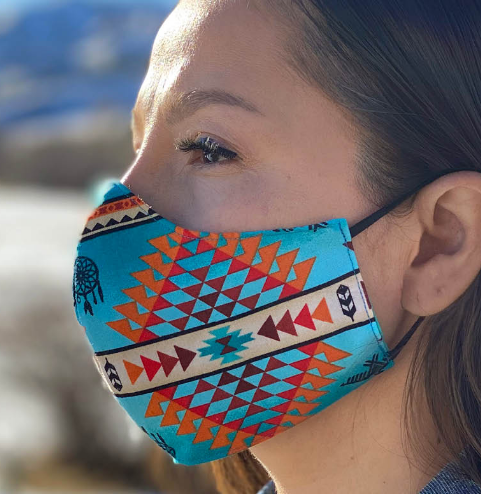
- Details
- By Levi Rickert
What some are calling the fifth surge since the pandemic began almost two years ago, the Omicron variant is causing an unprecedented spike in COVID-19 cases and causing a severe strain on hospital capacity across the country. On Friday, NBC News reported COVID cases were up 204 percent as compared to the two prior weeks.
At mid-week, Indian Health Service (IHS) Chief Medical Officer Dr. Loretta Christensen provided Native News Online a statement that said all 12 service areas serving Indian Country have seen “a significant increase” of positive COVID-19 cases in the last few weeks. The positivity rate more than tripled from the day after Christmas through the new year, compared to the week leading up to the holiday, IHS data shows.
We know since the beginning of the pandemic Indian Country has already suffered greatly. Data from the Centers for Disease Control and Prevention (CDC) show that American Indians and Alaska Natives were 3.3 times more likely to be hospitalized and 2.2 times more likely to die from COVID-19 than their white counterparts.
Want more Native News? Get the free daily newsletter today.
No place in Indian Country has suffered more than the Navajo Nation from COVID-19, which has served as the epicenter of Indian Country during the pandemic. The Navajo Nation announced on Friday the overall total number of positive COVID-19 reached 42,622 positive COVID-19 cases since March 17, 2020. The death toll from the deadly virus is approaching 1,600.
On Wednesday, the Navajo Nation announced its first known case of the Omicron variant.
“Our frontline warriors are pleading for all of our people to get fully vaccinated for COVID-19 and to get a booster shot if you’re eligible. The vaccines do not guarantee that you won’t get COVID-19, but they are highly effective in preventing severe symptoms and they are saving lives every day across the country. The data shows that the majority of those who are severely ill and losing their lives to COVID-19 are the unvaccinated individuals. Our health care system here on the Navajo Nation is being challenged, but our frontline warriors are fighting hard for all of us. Let’s fight for them by getting vaccinated and stepping up our efforts to be cautious and to take extra precautions," Navajo Nation President Jonathan Nez said on Friday.
The good news for Indian Country is tribal communities have some of the highest percent of vaccinations among all Americans. The IHS reports more than 1.7 million COVID-19 vaccinations have been administered to tribal citizens, tribal health care workers and essential workers in Indian Country. On the Navajo Nation, the country’s largest Indian reservation, 70 percent of the population was fully vaccinated by September, versus 58 percent of the general population nationwide.
Since last May, Native Roots Radio, supported by the We Can Do This Campaign, has hosted various regional town halls that brings together tribal leadership, community advocates and health experts to talk about the #COVID19 pandemic in #IndianCountry and the safety and effectiveness of the vaccines.
The town halls are marketed by a slogan that reads, “Keeping the Circle Strong: We Can Do This Indian Country.”
Within tribal culture, the word circle is a powerful symbolic representation of strength and resiliency.
While still in the early days of 2022, we know the resiliency of Native Americans throughout history prevailed through generation after generation because of the sheer determination to survive by our ancestors. Those of us who remain are still here because of their strength.
The last part of the marketing says, “We Can Do This Indian Country.” These are call to action words. These are not mere words of willpower. These are words that call for action of knowing when to distance ourselves from our loved ones for the sake of good health. They are words of action to get the proper vaccinations and boosters.
“We Can Do This Indian Country” are words of action to keep our tribal community circles strong.
We can do this Indian Country in 2022 and beyond!
More Stories Like This
Senator Ben Nighthorse Campbell Proved Representation MattersThe Lie We Keep Telling About Wounded Knee
Another Weapon of Mass Destruction
Colorado cannot heal until it confronts Sand Creek honestly
Native American Mothers Deserve to Live
Help us defend tribal sovereignty.
At Native News Online, our mission is rooted in telling the stories that strengthen sovereignty and uplift Indigenous voices — not just at year’s end, but every single day.
Because of your generosity last year, we were able to keep our reporters on the ground in tribal communities, at national gatherings and in the halls of Congress — covering the issues that matter most to Indian Country: sovereignty, culture, education, health and economic opportunity.
That support sustained us through a tough year in 2025. Now, as we look to the year ahead, we need your help right now to ensure warrior journalism remains strong — reporting that defends tribal sovereignty, amplifies Native truth, and holds power accountable.
 The stakes couldn't be higher. Your support keeps Native voices heard, Native stories told and Native sovereignty defended.
The stakes couldn't be higher. Your support keeps Native voices heard, Native stories told and Native sovereignty defended.
Stand with Warrior Journalism today.
Levi Rickert (Potawatomi), Editor & Publisher

